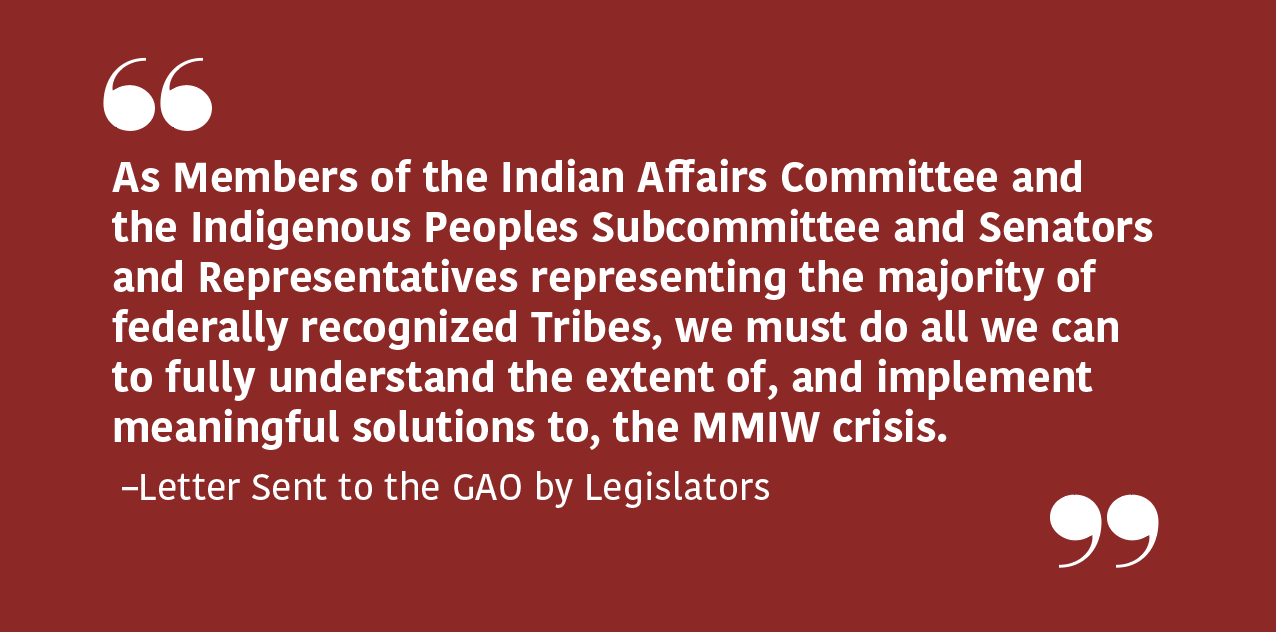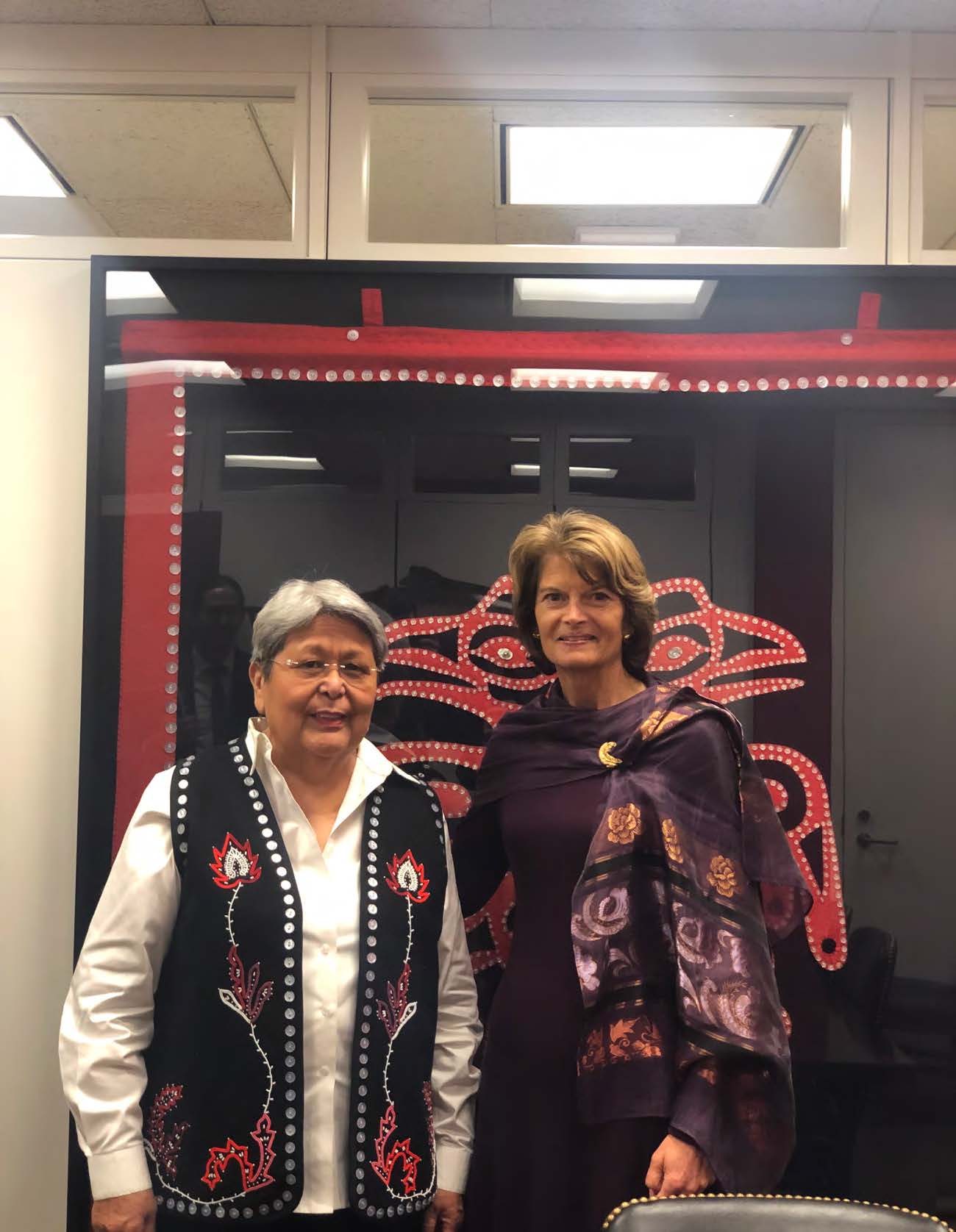Government Accountability Office Releases MMIW Report
“Missing or Murdered Indigenous Women: New Efforts Are Underway but Opportunities Exist to Improve the Federal Response”
The reality that no federal agency can answer the question of how many Indigenous women are missing or have been murdered was again confirmed by the recent October 2021 GAO Report.
“The total number of missing or murdered AI/AN women is unknown, because federal databases do not contain comprehensive national data, including comprehensive data from tribal, state and local law enforcement entities.” (GAO-22-104045, Missing and Murdered Indigenous Women, page 17.)
In 2019, 17 Senators and Representatives asked the government’s top watchdog to conduct a review of how federal, state, and Tribal agencies respond to missing and murdered Indigenous women (MMIW) cases. The request was a result of the oversight hearings held by both the Senate Indian Affairs Committee and the House Subcommittee for Indigenous Peoples to examine the federal response to the MMIW crisis.
The 17 legislators led by Senators Tester, Hoeven, and Udall and Representatives Gallego, Cook, and Grijalva signed a letter asking GAO to conduct a review of law enforcement response to the MMIW crisis. The letter was also signed by U.S. Senators Catherine Cortez Masto (D-Nev.), Tina Smith (D-Minn.), Steve Daines (R-Mont.), Jerry Moran (R-Kan.), John Barrasso (R-Wyo.), Maria Cantwell (D-Wash.), Brian Schatz (D-Hawaii), and Lisa Murkowski (R- Alaska), as well as U.S. Representatives Matt Cartwright (D-Pa.), Ed Case (D-Hawaii), and Deb Haaland (D-N.M.).
“As Members of the Indian Affairs Committee and the Indigenous Peoples Subcommittee and Senators and Representatives representing the majority of federally recognized Tribes, we must do all we can to fully understand the extent of, and implement meaningful solutions to, the MMIW crisis,” the legislators wrote to Comptroller General Gene Dodaro. “Federal officials, tribal leaders, and members of families directly impacted by the MMIW crisis all agreed that failures in cross-jurisdictional coordination, inadequate MMIW reporting protocols, and poor data collection limit the effectiveness of efforts to track, investigate, and solve MMIW cases.”
The new GAO report provides and confirms many of the concerns of Tribal leaders, the families of MMIW, Tribal stakeholders including law enforcement, and others. The findings and recommendations of the 63-page report are concerning in that it highlights the failure of the Department of Justice (DOJ) and Department of Interior (DOI) to meet statutorily created deadlines enacted to respond to the crisis of MMIW. Significant portions of the report are provided below and the full report is available at: n8ve.net/Vygom.
What GAO Found
The total number of missing or murdered Indigenous women—referred to as American Indian and Alaska Native (AI/AN) women in this report—is unknown because, for several reasons, federal databases do not contain comprehensive national data on all AI/AN women reported missing. For example, federal law requires federal, state, and local law enforcement agencies—but not Tribal law enforcement agencies—to report missing children under the age of 21, but not those over 21. In addition, instances of missing AI/AN women may be underreported due to mistrust of law enforcement and other reasons.
Implementation of data-related requirements in two laws, enacted in October 2020, present opportunities to increase and improve data on the number of missing or murdered Indians, including AI/AN women. For example, Savanna's Act requires Tribal consultations on how to improve Tribal data relevance and access to databases. The DOJ has taken some steps to analyze data in federal databases related to cases of missing or murdered AI/AN women, including publishing more detailed single-year statistics in 2020 on missing persons by race, gender, and age. However, data analyses efforts are in the early stages, and DOJ does not have a plan to continue these efforts past November 2021. Developing such a plan could provide DOJ and other stakeholders with information to better understand the nature of the missing or murdered AI/AN crisis and identify emerging trends.
Relevant DOJ and DOI law enforcement agencies that investigate cases of missing or murdered Indian women in Indian country have engaged in other efforts to address the crisis, but they have not implemented certain requirements to increase intergovernmental coordination and data collection in the two 2020 laws, which remain unfulfilled past their statutory deadlines. For example, the Not Invisible Act of 2019 requires the Secretary of the Interior, in coordination with the Attorney General, to appoint members to a Joint Commission on Reducing Violence Against Indians by February 7, 2021, but as of October 15, 2021, no members have been appointed, and a draft plan to meet this requirement does not include milestones for all interim steps. Developing plans to meet this and other unfulfilled statutory requirements would provide more assurance that DOJ and DOI will meet their legal responsibilities, and support Tribal partners in reducing violent crime.

Why GAO Did This Study
According to researchers, AI/AN women in the U.S. experience higher rates of violence than most other women, and Tribal and federal officials have stated that this incidence of violence constitutes a crisis. Various federal officials and Tribal stakeholders have raised concerns about challenges with cross-jurisdictional cooperation and a lack of comprehensive national data on cases.
GAO was asked to review the federal response to the missing or murdered AI/AN women crisis. This report examines the extent to which (1) the number of missing or murdered AI/AN women in the U.S. is known and (2) DOJ and DOI have taken steps to address the crisis. GAO reviewed available data on missing persons and violent deaths, relevant reports, and agency documentation, including agency policies and procedures. Using agency data—which were determined to be reliable for location selection—and qualitative factors, GAO selected seven locations to interview federal, state, local, and Tribal law enforcement officials; Tribal officials; and nongovernmental victim service providers on the federal response to the crisis.

Recommendations
GAO is making four recommendations, including that DOJ develop a plan for how it will accomplish ongoing analyses of missing or murdered AI/AN women data and that DOJ and DOI both develop plans to implement the requirements in Savanna's Act and the Not Invisible Act of 2019 that remain unfulfilled past their statutory deadlines. Both agencies concurred with the recommendations.
Four GAO Recommendations
Department of Justice
The Attorney General should develop a plan—including key steps, who will achieve them, and by when—for accomplishing ongoing analyses of data in existing federal databases and future data that may be gathered to identify relevant trends in cases of missing or murdered American Indian and Alaska Native women and areas of concern.
Department of Justice
The Attorney General should develop a plan, including milestone dates, to develop and implement a dissemination strategy to educate the public about the National Missing and Unidentified Persons System (NamUS).
Department of Justice
The Attorney General should develop a plan, including milestone dates, to conduct specific outreach to Indian Tribes, Tribal organizations, and urban Indian organizations regarding the ability to publicly enter information regarding missing persons through NamUs or other non-law enforcement sensitive portals.
Department of the Interior
The Secretary of the Interior, in coordination with the Attorney General, should finalize its draft plan establishing and appointing all members to the Joint Commission on Reducing Violent Crime Against Indians, as required by the Not Invisible Act of 2019, and include milestone dates for all steps in the process.





